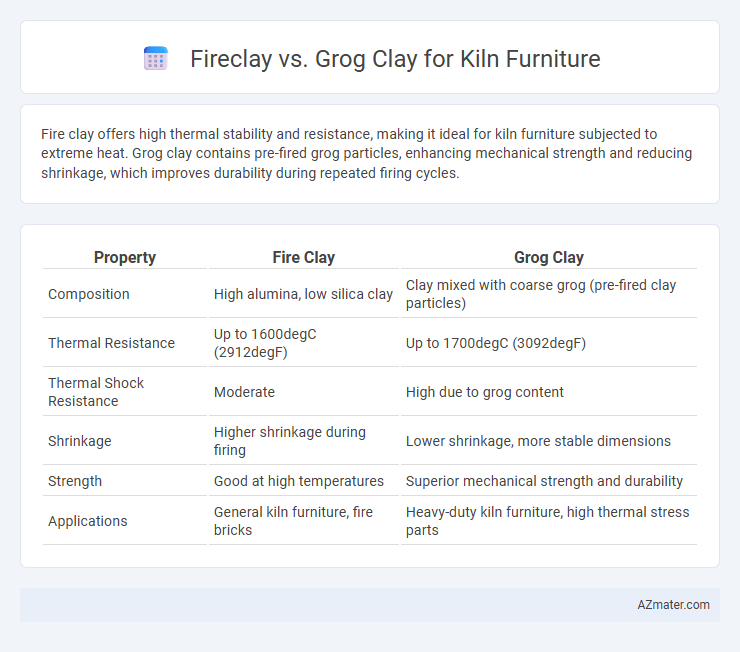Fire clay offers high thermal stability and resistance, making it ideal for kiln furniture subjected to extreme heat. Grog clay contains pre-fired grog particles, enhancing mechanical strength and reducing shrinkage, which improves durability during repeated firing cycles.
Table of Comparison
| Property | Fire Clay | Grog Clay |
|---|---|---|
| Composition | High alumina, low silica clay | Clay mixed with coarse grog (pre-fired clay particles) |
| Thermal Resistance | Up to 1600degC (2912degF) | Up to 1700degC (3092degF) |
| Thermal Shock Resistance | Moderate | High due to grog content |
| Shrinkage | Higher shrinkage during firing | Lower shrinkage, more stable dimensions |
| Strength | Good at high temperatures | Superior mechanical strength and durability |
| Applications | General kiln furniture, fire bricks | Heavy-duty kiln furniture, high thermal stress parts |
Introduction to Kiln Furniture Materials
Fire clay and grog clay are essential kiln furniture materials designed to withstand high temperatures and thermal shock in ceramic firing processes. Fire clay offers high refractory properties and plasticity, making it ideal for molding intricate shapes, while grog clay contains pre-fired clay particles that enhance strength and dimensional stability by reducing shrinkage during firing. Selecting between fire clay and grog clay depends on the specific thermal requirements and mechanical stress tolerance needed for kiln shelf supports, setters, and posts.
What is Fire Clay?
Fire clay is a highly refractory material composed mainly of kaolinite, known for its excellent heat resistance and thermal stability, making it ideal for kiln furniture applications. It can withstand temperatures exceeding 1600degC without deformation or chemical breakdown, ensuring durability in high-temperature environments. Fire clay's fine particle size contributes to its strength and machinability, providing a reliable base for kiln shelves, setters, and supports compared to grog clay, which includes larger, coarse grog particles for added thermal shock resistance.
What is Grog Clay?
Grog clay is a type of refractory material composed of ground-up fired clay, specifically processed to enhance its thermal shock resistance and structural stability in kiln furniture applications. Its granular texture improves the clay body's porosity and reduces shrinkage during firing, making it ideal for supporting ceramics at high temperatures. Compared to pure fire clay, grog clay offers greater durability and resistance to cracking, crucial for maintaining the integrity of kiln shelves, posts, and stilts under repeated thermal cycles.
Composition Differences: Fire Clay vs Grog Clay
Fire clay primarily consists of kaolinite and other clay minerals with high alumina content, offering excellent heat resistance and plasticity for kiln furniture applications. Grog clay incorporates pre-fired, crushed ceramic materials, known as grog, which reduce shrinkage and increase thermal shock resistance by adding coarse, inert particles to the clay matrix. The key composition difference lies in fire clay's fine, homogeneous mineral makeup versus grog clay's composite structure that enhances durability and dimensional stability under high temperatures.
Thermal Stability and Heat Resistance
Fire clay exhibits high thermal stability with a melting point around 1,750degC, making it suitable for kiln furniture exposed to intense heat. Grog clay, enriched with pre-fired grog particles, enhances heat resistance and reduces shrinkage during firing, providing improved dimensional stability under thermal stress. The porous structure of grog clay aids in thermal shock resistance, whereas fire clay offers a denser, more uniform heat distribution.
Mechanical Strength and Durability
Fire clay kiln furniture exhibits high mechanical strength and excellent thermal shock resistance, making it suitable for long-term use in high-temperature environments. Grog clay enhances durability by incorporating coarse grog particles, which improve structural integrity and reduce shrinkage during firing. The combination of fire clay's toughness and grog's reinforcement results in kiln furniture that withstands repeated thermal cycles and mechanical stresses effectively.
Workability and Forming Techniques
Fire clay offers superior workability due to its fine particle size and plasticity, allowing for intricate shaping and smooth surface finishes in kiln furniture production. Grog clay contains pre-fired grog particles that enhance dimensional stability and reduce shrinkage but can make the material coarser and less pliable, requiring more effort during forming. Techniques such as hand-building and pressing are easier with fire clay, while grog clay is better suited for extrusion or slip casting where added strength during drying and firing is beneficial.
Cost Comparison: Fire Clay vs Grog Clay
Fire clay generally costs less than grog clay due to its lower processing requirements and more abundant natural deposits. Grog clay, with its added ground fired clay particles, often commands a higher price because of improved thermal shock resistance and durability essential for kiln furniture performance. The choice between fire clay and grog clay balances cost considerations with the specific structural and thermal properties needed in kiln furniture applications.
Best Applications for Each Clay Type
Fire clay exhibits excellent thermal shock resistance and high refractoriness, making it ideal for kiln shelves and bricks exposed to extreme temperatures in high-fire ceramics and metal casting. Grog clay contains pre-fired clay granules, enhancing structural strength and reducing shrinkage, which suits it for kiln posts, setters, and furniture requiring dimensional stability and durability under repeated thermal cycling. Each clay type optimizes kiln furniture performance by balancing heat resistance and mechanical strength specific to their firing environment and load requirements.
Choosing the Right Clay for Your Kiln Furniture
Fire clay offers high refractory properties and thermal shock resistance, making it ideal for kiln furniture subjected to intense heat cycles. Grog clay contains pre-fired grog particles that enhance mechanical strength and reduce shrinkage, improving dimensional stability during firing. Selecting the right clay depends on the kiln's maximum temperature, load weight, and desired durability of the kiln furniture.

Infographic: Fire clay vs Grog clay for Kiln furniture
 azmater.com
azmater.com